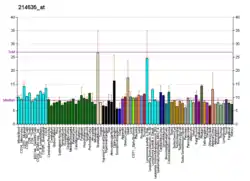| CLDN9 | |||||||||||||||||||||||||||||||||||||||||||||||||||
|---|---|---|---|---|---|---|---|---|---|---|---|---|---|---|---|---|---|---|---|---|---|---|---|---|---|---|---|---|---|---|---|---|---|---|---|---|---|---|---|---|---|---|---|---|---|---|---|---|---|---|---|
| Identifiers | |||||||||||||||||||||||||||||||||||||||||||||||||||
| Aliases | CLDN9, claudin 9, DFNB116 | ||||||||||||||||||||||||||||||||||||||||||||||||||
| External IDs | OMIM: 615799 MGI: 1913100 HomoloGene: 10656 GeneCards: CLDN9 | ||||||||||||||||||||||||||||||||||||||||||||||||||
| |||||||||||||||||||||||||||||||||||||||||||||||||||
| |||||||||||||||||||||||||||||||||||||||||||||||||||
| |||||||||||||||||||||||||||||||||||||||||||||||||||
| |||||||||||||||||||||||||||||||||||||||||||||||||||
| |||||||||||||||||||||||||||||||||||||||||||||||||||
| Wikidata | |||||||||||||||||||||||||||||||||||||||||||||||||||
| |||||||||||||||||||||||||||||||||||||||||||||||||||
Claudin-9 is a protein that in humans is encoded by the CLDN9 gene.[5][6][7] It belongs to the group of claudins.
This gene is expressed in the inner ear, olfactory epithelium, and anterior pituitary gland [8] and is involved in hearing.[9][10][11]
References
- 1 2 3 GRCh38: Ensembl release 89: ENSG00000213937 - Ensembl, May 2017
- 1 2 3 GRCm38: Ensembl release 89: ENSMUSG00000066720 - Ensembl, May 2017
- ↑ "Human PubMed Reference:". National Center for Biotechnology Information, U.S. National Library of Medicine.
- ↑ "Mouse PubMed Reference:". National Center for Biotechnology Information, U.S. National Library of Medicine.
- ↑ Peacock RE, Keen TJ, Inglehearn CF (Mar 1998). "Analysis of a human gene homologous to rat ventral prostate.1 protein". Genomics. 46 (3): 443–9. doi:10.1006/geno.1997.5033. PMID 9441748.
- ↑ Meertens L, Bertaux C, Cukierman L, Cormier E, Lavillette D, Cosset FL, Dragic T (Mar 2008). "The tight junction proteins claudin-1, -6, and -9 are entry cofactors for hepatitis C virus". J Virol. 82 (7): 3555–60. doi:10.1128/JVI.01977-07. PMC 2268462. PMID 18234789.
- ↑ "Entrez Gene: CLDN9 claudin 9".
- ↑ Higashi AY, Higashi T, Furuse K, Ozeki K, Furuse M, Chiba H (Nov 2021). "Claudin-9 constitutes tight junctions of folliclo-stellate cells in the anterior pituitary gland". Scientific Reports. 11 (1): 21642. Bibcode:2021NatSR..1121642H. doi:10.1038/s41598-021-01004-z. PMC 8568902. PMID 34737342.
- ↑ Gene discovery reveals a critical protein's function in hearing
- ↑ Nakano Y, Kim SH, Kim HM, Sanneman JD, Zhang Y, Smith RJ, Marcus DC, Wangemann P, Nessler RA, Bánfi B (Aug 2009). "A claudin-9-based ion permeability barrier is essential for hearing". PLOS Genetics. 5 (8): e1000610. doi:10.1371/journal.pgen.1000610. PMC 2720454. PMID 19696885.
- ↑ Sineni CJ, Yildirim-Baylan M, Guo S, Camarena V, Wang G, Tokgoz-Yilmaz S, Duman D, Bademci G, Tekin M (Oct 2019). "A truncating CLDN9 variant if associated with autosomal recessive nonsyndromic hearing loss". Human Genetics. 138 (10): 1071–1075. doi:10.1007/s00439-019-02037-1. PMC 6745279. PMID 31175426.
External links
- Human CLDN9 genome location and CLDN9 gene details page in the UCSC Genome Browser.
Further reading
- Kniesel U, Wolburg H (2000). "Tight junctions of the blood–brain barrier". Cell. Mol. Neurobiol. 20 (1): 57–76. doi:10.1023/A:1006995910836. PMID 10690502. S2CID 26473781.
- Heiskala M, Peterson PA, Yang Y (2001). "The roles of claudin superfamily proteins in paracellular transport". Traffic. 2 (2): 93–8. doi:10.1034/j.1600-0854.2001.020203.x. PMID 11247307. S2CID 12132159.
- Tsukita S, Furuse M, Itoh M (2001). "Multifunctional strands in tight junctions". Nat. Rev. Mol. Cell Biol. 2 (4): 285–93. doi:10.1038/35067088. PMID 11283726. S2CID 36524601.
- Tsukita S, Furuse M (2003). "Claudin-based barrier in simple and stratified cellular sheets". Curr. Opin. Cell Biol. 14 (5): 531–6. doi:10.1016/S0955-0674(02)00362-9. PMID 12231346.
- González-Mariscal L, Betanzos A, Nava P, Jaramillo BE (2003). "Tight junction proteins". Prog. Biophys. Mol. Biol. 81 (1): 1–44. doi:10.1016/S0079-6107(02)00037-8. PMID 12475568.
- Yi X, Wang Y, Yu FS (2000). "Corneal epithelial tight junctions and their response to lipopolysaccharide challenge". Invest. Ophthalmol. Vis. Sci. 41 (13): 4093–100. PMID 11095601.
- Kiuchi-Saishin Y, Gotoh S, Furuse M, et al. (2002). "Differential expression patterns of claudins, tight junction membrane proteins, in mouse nephron segments". J. Am. Soc. Nephrol. 13 (4): 875–86. doi:10.1681/ASN.V134875. PMID 11912246.
- Strausberg RL, Feingold EA, Grouse LH, et al. (2003). "Generation and initial analysis of more than 15,000 full-length human and mouse cDNA sequences". Proc. Natl. Acad. Sci. U.S.A. 99 (26): 16899–903. Bibcode:2002PNAS...9916899M. doi:10.1073/pnas.242603899. PMC 139241. PMID 12477932.
- Katoh M, Katoh M (2004). "CLDN23 gene, frequently down-regulated in intestinal-type gastric cancer, is a novel member of CLAUDIN gene family". Int. J. Mol. Med. 11 (6): 683–9. doi:10.3892/ijmm.11.6.683. PMID 12736707.
- Ban Y, Dota A, Cooper LJ, et al. (2003). "Tight junction-related protein expression and distribution in human corneal epithelium". Exp. Eye Res. 76 (6): 663–9. doi:10.1016/S0014-4835(03)00054-X. PMID 12742348.
- Kitajiri SI, Furuse M, Morita K, et al. (2004). "Expression patterns of claudins, tight junction adhesion molecules, in the inner ear". Hear. Res. 187 (1–2): 25–34. doi:10.1016/S0378-5955(03)00338-1. PMID 14698084. S2CID 31183039.
- Ota T, Suzuki Y, Nishikawa T, et al. (2004). "Complete sequencing and characterization of 21,243 full-length human cDNAs". Nat. Genet. 36 (1): 40–5. doi:10.1038/ng1285. PMID 14702039.
- Gerhard DS, Wagner L, Feingold EA, et al. (2004). "The status, quality, and expansion of the NIH full-length cDNA project: the Mammalian Gene Collection (MGC)". Genome Res. 14 (10B): 2121–7. doi:10.1101/gr.2596504. PMC 528928. PMID 15489334.
- Zheng A, Yuan F, Li Y, et al. (2007). "Claudin-6 and claudin-9 function as additional coreceptors for hepatitis C virus". J. Virol. 81 (22): 12465–71. doi:10.1128/JVI.01457-07. PMC 2169001. PMID 17804490.
- Liu F, Koval M, Ranganathan S, Fanayan S, Hancock WS, Lundberg EK, Beavis RC, Lane L, Duek P, McQuade L, Kelleher NL, Baker MS (2015). "A systems proteomics view of the endogenous human claudin protein family". J Proteome Res. 15 (2): 339–359. doi:10.1021/acs.jproteome.5b00769. PMC 4777318. PMID 26680015.
This article is issued from Wikipedia. The text is licensed under Creative Commons - Attribution - Sharealike. Additional terms may apply for the media files.




